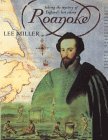New World and Pacific
Mysterious Ancient America
Paul Devereux

Drawing on Paul Devereux’s own original research and the findings of many scholars, scientists and explorers, this book provides a succinct yet comprehensive survey of an almost-forgotten ancient dimension of the Americas, North and South.
For example:
Did the American Indians arrive from the Atlantic or the Pacific side of America?
Who built the pyramids and the gigantic ceremonial earth structures of the Americas?
What is the explanation of the mysterious Nazca Lines?
What are the origins of the ancient non-Indian skeletons in America?
Why did pre-historic South America have pottery identical to that of the stone-age Jomon of Japan?
Presented in an accessible manner for the general reader, never has such a rounded portrait of the New World’s enigmatic ancient face, its unsolved puzzles and its half-hidden history been given in a single volume.
Roanoke: Solving the Mystery of the Lost Colony
Lee Miller

Review by Shanti Faiia
The London Times has said of Lee Miller’s Roanoke that ;
« Miller brings something fresh to the quest. . . . The result is a believable and heartbreaking story of hoped-for collaborations, misunderstandings, mistakes and betrayals which ends in disaster. . . . The story is told with a verve which makes it . . . a page-turner. » -Times
Anyone who likes a good mystery will love Lee Miller’s Roanoke. For it is more than a well written story, it is an account of the existing past and the horrors that a living mystery can contain. Miller evokes our past, detailing life as it was during the 16th century for adventurers of the seas, for colonists arriving upon a new and foreign land, and for members of the English gentry and Royalty. Colour and texture is given to a forgotten time, and the reader is swept up into a bewildering tangle of half clues and suggestions that when taken in their ensemble, lead to a crime that is chilling in its complexity.
The story Miller tells is one of betrayal, deception, and calculated treachery. In 1587, an English colony of 116 people is left on Roanoke Island. The widely accepted version of their fate is that they then disappear without a trace. Yet Miller would have us believe otherwise, and proceeds to retell a history that is shocking in its detail of the coincidences and misrepresentations that led to a whole colony’s disappearance. Finally, we are presented with proof of sabotage and murder that has been veiled with silence for more than 400 years.
In following Miller’s reconstruction of history, we come to ask, how could 116 people just vanish into thin air ? Why was there no trace of them at all ? No houses, no personal belongings, and no corpses. Only one carving on a tree with the letters CROATOAN. Were the settlers killed by American Indians who owned the lands on which they were to live ? Or were they killed by Spanish raiders looking to weaken England ? Did they starve to death, and if so, why were their bodies not found ? Did they move to Croatoan, as it would seem from the carved tree ? If so, why were they not found there ? In answering these questions, Miller uncovers more than the mystery of a lost colony. She brings to light a much broader plot involving Queen Elizabeth I’s close circle of advisors and the well renowned Sir Walter Raleigh. It is a plot that brings to life the power play that runs rife among the individuals running England at the time. A plot that shows how the politically and economically powerful can get away with using people as pawns in the games they wish to play.
The London Times is correct in saying that Miller brings something fresh to the quest for this lost colony. With a freshness of style, a dry historical account is transformed into a mystery that the reader actively works through with Miller. Part of the intrigue of this mystery is that Miller brings the voices of those people involved with the Roanoke colony alive. She does this by integrating quotes from the people she is speaking of into the actual text. The story flows between her words and the words of a bygone era with ease, plunging the reader into the 16th Century.
Read this book, and you will end it with a different perception of history and how it is told. History can be a powerful weapon. It can conceal, or as in this case, reveal events that cause us to question what we know as truth.
The Secret of the Incas
William Sullivan

This is a great book about the astronomical significance of Inca folklore. Sullivan was inspired by Santillan and Von Dechend’s Hamlet’s Mill, to which Graham also owes a lot and which is also recommended on this site. Sullivan takes us on his fascinating journey towards a better understanding of the strange-yet-familiar Andean stories.




